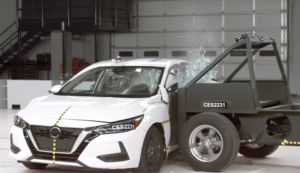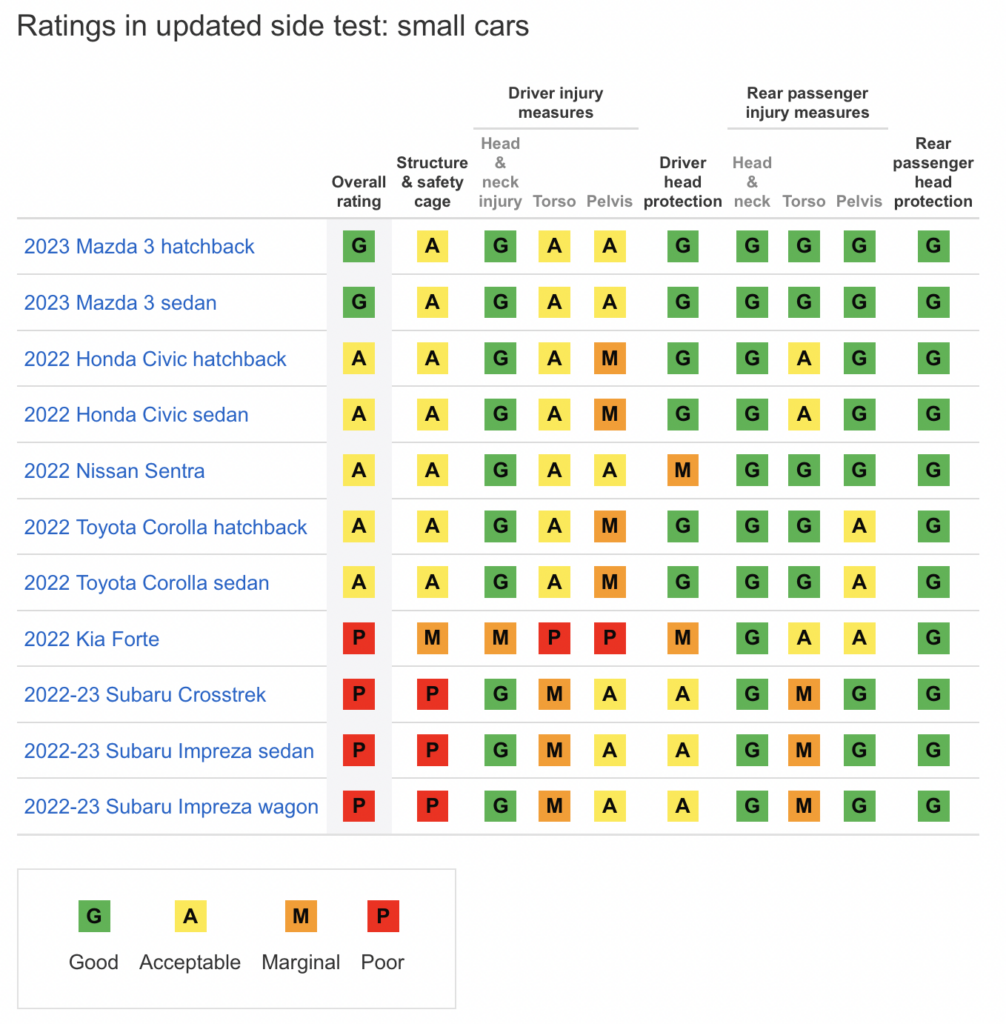
IIHS: Some small cars rated poor in simulated side impact by SUVs
By onAnnouncements
An Insurance Institute for Highway Safety (IIHS) side impact test redesigned last year to reflect the effects of a larger, heavier vehicle moving at a higher speed has resulted in poor ratings for four of 11 small sedans and hatchbacks tested.
The new barrier weighs 4,200 pounds — close to the weight of today’s midsize SUVs — and strikes the test vehicle at 37 mph, compared with a 3,300-pound barrier traveling at 31 mph in the original evaluation. Together, those two changes mean the test involves 82% more energy.
In the test, only the Mazda 3 sedan and Mazda 3 hatchback earned good ratings. Five other vehicles — the Nissan Sentra, Toyota Corolla sedan, Toyota Corolla hatchback, Honda Civic sedan, and Honda Civic hatchback — were rated acceptable.
Earning poor ratings were the Kia Forte, Subaru Crosstrek, and Subaru Impreza sedan and wagon.
All 11 vehicles had earned good ratings in the original version of the test, which had been in use since 2003. The revised test was introduced in 2021.
RDN reached out to Kia and Subaru on Friday for their perspectives on the test, and had not received any replies as of deadline.
“It’s encouraging to see so many small cars with passing grades in this new side test,” said IIHS Senior Research Engineer Becky Mueller, who led the development of the evaluation. “Smaller, lower vehicles are at a disadvantage when struck by the new test barrier, which is a more realistic representation of the front end of a typical modern SUV than our old barrier. Clearly, some manufacturers have already figured out how to provide sufficient protection in a crash like this even for occupants of small cars.”
Only the Mazda 3 sedan and Mazda 3 hatchback earned good ratings. The Nissan Sentra, Toyota Corolla sedan, Toyota Corolla hatchback, Honda Civic sedan, and Honda Civic hatchback were rated acceptable, one step up from marginal on the IIHS scale.
Beginning in 2023, the updated test will be included in the IIHS award criteria, with a rating of good or acceptable required for the Top Safety Pick award, and a good rating required for the higher-tier Top Safety Pick+.
In previous tests, other classes of vehicles have also struggled. In a test of 20 small SUVs announced in October 2021, just one earned a good rating, with nine rated acceptable, eight marginal, and two poor. Similarly, in a test of seven midsize sedans conducted in May 2022, only one was rated good, with two rated acceptable, one marginal, and three poor. Only midsize SUVs have done relatively well, with 10 of 18 rated good, two acceptable, and six marginal in a May 2022 test.
Joe Young, director of media relations for IIHS, told Repairer Driven News that the institute approached changes to its test by examining “real-world crashes in which people were still being injured or killed in side crashes in vehicles that performed well in our original side crash test.”
“There’s certainly a concern that as vehicles become larger and heavier, especially with more EVs on the road, those inside smaller vehicles will be at increased risk in a multivehicle crash, and this is a trend we’ll continue to keep an eye on as we reevaluate our test programs,” Young told RDN.
IIHS offered no perspectives on why one small car might have performed better than another, but pointed out that vehicles with a higher ride height tended to perform better in previous tests.
“A taller vehicle means the moving barrier strikes nearer to the floor of the occupant compartment. The results from the small cars suggest that vehicle length — in particular, the length of the occupant compartment— may also play a role,” IIHS said.
Raul Arbelaez, vice president of the Institute’s Vehicle Research Center, said, “Doors tend to be weaker than the B-pillar and the frame surrounding the occupant compartment. Small cars have less of that weaker space because of their shorter wheelbase and occupant compartment.”
IIHS provided some details of the results, by vehicle:
- Mazda3: “The structure and safety cage of the good-rated Mazda 3 vehicles held up well in the new test, and the head-protecting airbags for both the driver and rear passenger prevented the dummies’ heads from hitting the hard surfaces of the vehicle interior. As a result, there was a low risk of most injury types. However, there was a moderate risk of injuries to the driver’s torso and pelvis.”
- Honda Civic, Toyota Corolla: “Injury measurements also indicated a significant risk of injury to the driver’s pelvis in both the Civics and Corollas and a moderate risk of an injury to the driver’s pelvis in the Sentra. The risk of a torso injury was moderate for both the driver and rear passenger in the Civics, while measurements indicated a moderate risk for the driver and a significant risk for the rear passenger in the Civics.”
- Kia Forte: “For the poor-rated Forte, measurements taken from the driver dummy indicated a high risk of injuries to the torso and pelvis and a relatively high risk of a head or neck injury. The driver dummy’s head made hard impact with the windowsill through the side curtain airbag, and the structure of the occupant compartment was not maintained well, contributing to a moderate risk of injuries to the rear passenger’s torso and pelvis.”
- Subaru Crosstrek, Impreza: “For the poor-rated Crosstrek, whose test also applies to the Impreza sedan and Impreza wagon, there was more substantial intrusion of the B-pillar and interior door panels into the occupant compartment, encroaching on the survival space and contributing to a relatively high risk of torso injuries for the driver and rear passenger. The head of the driver dummy also moved downward past the side curtain airbag to hit the windowsill, indicating inadequate head protection.”
IIHS said the structure and safety cage held up “reasonably well” in all five vehicles rated acceptable, through the impact of the barrier caused a small amount of intrusion into the occupant compartment.
The head-protecting airbags for the driver and rear passenger on the Civics and Corollas prevented the dummies’ heads from striking the door and windowsill, helping to minimize the risk of head injuries, IIHS said. In the Sentra, the driver dummy’s head moved downward past the side curtain airbag to hit the windowsill, but the vehicle’s “solid performance in other areas” prevented a further downgrade in the vehicle’s rating.
The National Highway Traffic Safety Administration (NHTSA) also conducts a side barrier test, but the details are different. In the NHTSA test, a 3,015-pound moving barrier crashes into a stationary vehicle at 38.5 mph.
Images
Featured image: The 2022 Nissan Sentra earned an overall rating of acceptable in IIHS’s revised side impact test. (Screen capture via YouTube)
Chart provided by IIHS

